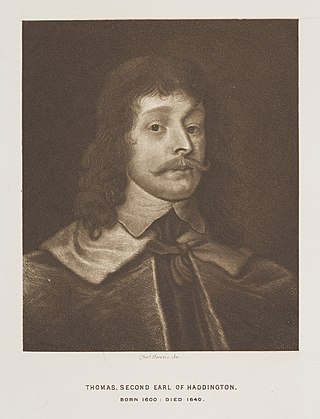Related Research Articles

Sir John Pringle, 1st Baronet was a British physician who has been called the "father of military medicine".
Baron Bruntisfield, of Boroughmuir in the City of Edinburgh, is a title in the Peerage of the United Kingdom. It was created in 1942 for the Scottish Conservative politician and former Vice-Chamberlain of the Household, Sir Victor Warrender, 8th Baronet. The Warrender family descends from George Warrender. He was Lord Provost of Edinburgh and represented Edinburgh in Parliament. In 1715 he was created a baronet, of Lochend in the County of Haddington, in the Baronetage of Great Britain. His grandson, the third Baronet, fought at the Battle of Minden in 1759, represented Haddington Burghs in the House of Commons and served as King's Remembrancer of the Court of Exchequer from 1771 to 1791. He was succeeded by his son, the fourth Baronet. He sat as a Member of Parliament for Haddington Burghs, Truro, Sandwich, Westbury and Honiton and notably served as a Lord of the Admiralty from 1812 to 1812. In 1822 Warrender was admitted to the Privy Council. On his death the title passed to his younger brother, the fifth Baronet. His grandson, the seventh Baronet, was a Vice Admiral in the Royal Navy. He was succeeded by his son, the eighth Baronet, who was raised to the peerage as Baron Bruntisfield, of Boroughmuir in the City of Edinburgh, in 1942. As of 2010 the titles are held by the latter's grandson, the third Baron, who succeeded in 2007. He is a retired officer in the British Army and investment banker.

Basil Hall was a British naval officer from Scotland, a traveller, and an author. He was the second son of Sir James Hall, 4th Baronet, an eminent man of science.
Sir James Hall of Dunglass, 4th Baronet FRS FRSE was a Scottish geologist and geophysicist. He was a Member of Parliament for St. Michael's borough 1807–1812.

Dunglass is a hamlet in East Lothian, Scotland, lying east of the Lammermuir Hills on the North Sea coast, within the parish of Oldhamstocks. It has a 15th-century collegiate church, now in the care of Historic Scotland. Dunglass is the birthplace of Sir James Hall, an 18th-century Scottish geologist and geophysicist. The name Dunglass comes from the Brittonic for "grey-green hill".

Sir David Dalrymple, Lord Hailes, 3rd Baronet of Hailes was a Scottish advocate, judge and historian, born in Edinburgh.

Thomas Hamilton, 1st Earl of Haddington, designated before his peerage as 'of Drumcarny, Monkland, and Binning', was a Scottish administrator, Lord Advocate, judge, and Lord Lieutenant of Haddingtonshire.

John Hay, 2nd Marquess of Tweeddale PC was a Scottish nobleman.

Clan Home is a Scottish clan. It held immense power for much of the Middle Ages and dominated the eastern Scottish Borders. It produced no fewer than eight Wardens of the Eastern March – more than any other family.
Sir David Dalrymple, 1st Baronet, of Hailes was a Scottish advocate and politician who sat in the Parliament of Scotland from 1698 to 1707 and in the British House of Commons from 1707 to 1721. He served as Lord Advocate, and eventually Auditor of the Exchequer in Scotland in 1720.
Sir John Lauder of Fountainhall, 3rd Baronet was born 3 and baptised 5 December 1669 at Greyfriars Kirk, Edinburgh, Midlothian, Scotland. He died in February 1728 at Fountainhall manor, near Pencaitland, and was interred in the Lauder burial vault within Greyfriars. He succeeded his father John Lauder, Lord Fountainhall in the baronetcy in September 1722.
Sir Francis Kinloch of Gilmerton, 3rd Baronet was a Scottish landowner.

Sir John Baird, 2nd Baronet, of Newbyth of Newbyth, Haddington, was a Scottish politician who sat in the House of Commons from 1715 to 1722.

There have been three baronetcies created for persons with the surname Kinloch, two in the Baronetage of Nova Scotia and one in the Baronetage of the United Kingdom. Two of the creations are extant as of 2010.
The Broun Baronets are a branch of the ancient Broun of Colstoun family whose estate near Haddington, East Lothian, remains to this day in the possession of a cadet family.
There have been four baronetcies created for persons with the surname Hall, one in the Baronetage of Nova Scotia and three in the Baronetage of the United Kingdom. Three of the creations are extant as of 2010.
Sir James Dalrymple, 2nd Baronet was Member of Parliament for Haddington Burghs and the Principal Auditor of the Exchequer in Scotland.

Thomas Hamilton, 2nd Earl of Haddington was a Scottish nobleman.
Sir Robert Murray of Cameron was a Scottish politician.
Sir John Hall of Dunglass, 1st Baronet (1650–1695) was a 17th-century Scottish merchant who twice served as Lord Provost of Edinburgh: from 1689 to 1691 and 1692 to 1694.
References
- ↑ Daniel Kemp, Richard Pococke's Tours through Scotland (Edinburgh, 1887), p. 326.
- Pringle of Stichill: the 3rd Baronet married Magdalen Pringle, while her aunt married Sir James Hall, of Dunglass, 2nd Bt.
- Ten Parishes of the County of Haddington, by John Martine, edited by E.J.Wilson, Haddington, 1894, p. 214.
- Burke's Peerage, Baronetage and Knightage, edited by Peter Townend, 105th edition, London, 1970.
- Leigh Rayment's list of baronets